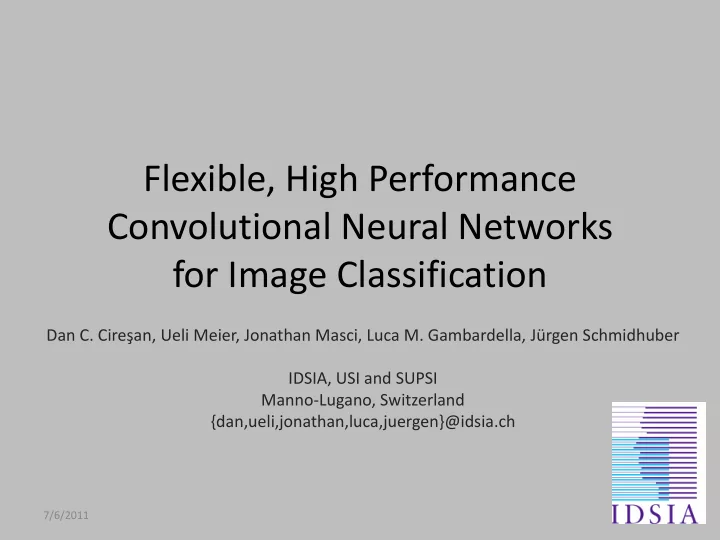

Flexible, High Performance Convolutional Neural Networks for Image Classification Dan C. Cireşan , Ueli Meier, Jonathan Masci, Luca M. Gambardella, Jürgen Schmidhuber IDSIA, USI and SUPSI Manno-Lugano, Switzerland {dan,ueli,jonathan,luca,juergen}@idsia.ch 7/6/2011
Introduction • Image recognition: text, objects. • Features or raw pixels? Learning features. • Convolutional Neural Networks. • How to train huge nets? GPUs … • Evaluation protocol for standard benchmarks. Flexible, High Performance Convolutional Neural Networks for Image Classification; D. Ciresan et al.
Convolutional Neural Networks (CNNs) • Hierarchical architecture for image recognition, loosely inspired from biology. • Introduced by Fukushima (80) and refined by LeCun et al.(98), Riesenhuber et al.(99), Simard et al.(03), Behnke (03). • Fully supervised, with randomly initialized filters, trained minimizing the misclassification error. • Flexible architecture. Flexible, High Performance Convolutional Neural Networks for Image Classification; D. Ciresan et al.
Convolutional layer Flexible, High Performance Convolutional Neural Networks for Image Classification; D. Ciresan et al.
Max-pooling layer • Introduces small translation invariance • Improves generalization Flexible, High Performance Convolutional Neural Networks for Image Classification; D. Ciresan et al.
Fully connected layer • One output neuron per class normalized with soft-max activation function Flexible, High Performance Convolutional Neural Networks for Image Classification; D. Ciresan et al.
Graphics processing units (GPUs) • 8 x GTX 480/580 1.5GB RAM • >12 TFLOPS (theoretical speed) • 40-80x speed-up compared with a single threaded CPU version of the CNN program (one day on GPU instead of two months on CPU) Flexible, High Performance Convolutional Neural Networks for Image Classification; D. Ciresan et al.
Back-propagation of deltas • Uses pooling of deltas. i K 1 i K 1 i i x y max , 0 x min , M 1 max , 0 min , 1 y M x y S 1 S 1 S 1 S 1 x x y y Flexible, High Performance Convolutional Neural Networks for Image Classification; D. Ciresan et al.
Experiments • Distorting images • Datasets: – Handwritten digits: MNIST – 3D models: NORB – Natural images: CIFAR10 • Evaluation protocol – Repeat experiment and compute mean and standard deviation Flexible, High Performance Convolutional Neural Networks for Image Classification; D. Ciresan et al.
Distortions • MNIST – Translation – Rotation – Scaling – Elastic • NORB and CIFAR10: only translation (random for both axes, maximum 5%) • Greatly improves generalization and recognition rate • Border effects Flexible, High Performance Convolutional Neural Networks for Image Classification; D. Ciresan et al.
MNIST • 28x28 grayscale images • 60000 for training and 10000 for testing • Simard et al. (2003) – 0.40%, Ciresan et al. (2010) – 0.35% • 30 out of 35 digits have a correct second prediction #M, #N in Hidden Layers TfbV [%] 20M-60M 1.02 20M-60M-150N 0.55 20M-60M-100M-150N 0.38 20M-40M-60M-80M-100M-120M-150N 0.35 Flexible, High Performance Convolutional Neural Networks for Image Classification; D. Ciresan et al.
Small NORB • 48600 96x96 stereo images • 5 classes with 10 instances • 5 instances for training and 5 for testing • bad/challenging dataset, only 5 instances/class, some instances from test set are completely different than the one from training set trans. [%] IP TfbV [%] runs time/epoch [s] • IP maps (Mexican hat) are needed only for 0 no 7.86 ± 0.55 50 1143 this data set 5 no 4.71 ± 0.57 50 1563 0 yes 3.94 ± 0.48 50 1658 • previous state of the art: Behnke et al. 2.87% 5 yes 2.53 ± 0.40 100 2080 mammal human plane truck car all mammal 0 22 13 2 3 40 human 35 0 0 0 0 35 plane 88 0 0 60 37 185 truck 19 0 0 0 7 26 car 79 0 0 246 0 325 Flexible, High Performance Convolutional Neural Networks for Image Classification; D. Ciresan et al.
CIFAR10 • small, 32x32 pixels color images • complex backgrounds • 10 classes • 50000 training images • 10000 test images • 19.51% error rate (state of the art) trans. [%] IP TfbV [%] Runs time/epoch [s] 0; 100M no 28.87 ± 0.37 11 93 0; 100M edge 29.11 ± 0.36 15 104 5; 100M no 20.26 ± 0.21 11 111 5; 100M edge 21.87 ± 0.57 5 120 5; 100M hat 21.44 ± 0.44 4 136 5; 200M no 19.90 ± 0.16 5 248 5; 300M no 19.51 ± 0.18 5 532 5; 400M No 19.54 ± 0.16 5 875 first layer filters Flexible, High Performance Convolutional Neural Networks for Image Classification; D. Ciresan et al.
Conclusions • Our big deep nets combining CNN and other ideas are now state of the art for many image classification tasks. • No need to extract handcrafted features. • Supervised training with simple gradient descent training is best. No need for unsupervised pre-training (e.g. autoencoders) in case of sufficient training samples. • Distorting the training set improves recognition rate on unseen data. • CPUs are not enough anymore, use GPUs which are 2 orders of magnitude faster. Robust (smallest error rates) and fast enough (10 3 -10 4 images/s) for immediate • industrial applications. Flexible, High Performance Convolutional Neural Networks for Image Classification; D. Ciresan et al.
What is next? • Results on all benchmarks already improved 20-50% compared with this paper. • Test the CNNs on different datasets: – already done: • Chinese characters: 3755 classes, >1M characters, 6.5% error rate, first place at ICDAR 2011 competition • Traffic signs: 43 classes, <1% error rate, first place at IJCNN 2011 competition • All Latin alphabet (NIST SD 19, >0.8M characters): state of the art results (ICDAR 2011) – next : • CALTECH 101 & 256, ImageNet, cluttered NORB • medical images • Use CNNs for general scene understanding (segmentation). • Robot vision applications (detect type, position and orientation of objects in a scene). • Computer vision applications (de-blurring, segmentation, similarity check etc.). • Try to reach and surpass human image classification performance. • More at www.idsia.ch/~ciresan Flexible, High Performance Convolutional Neural Networks for Image Classification; D. Ciresan et al.
Recommend
More recommend